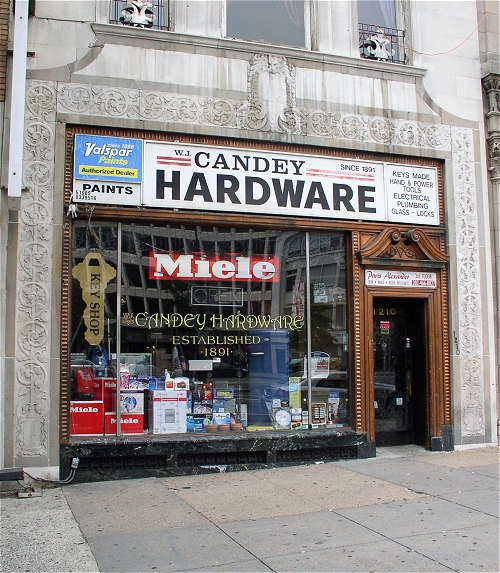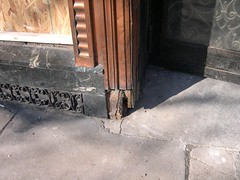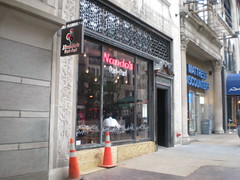This place mattered #3: the Candey's Hardware Storefront

Anatomy of a traditional commercial storefront. Illinois Historic Preservation Agency image.
In 2007, W.H. Candey Hardware, an independent hardware store holdout selling "convenience" house goods in an increasingly high-priced retail environment south of Dupont Circle on Connecticut Avenue (actually on the 1200 block of 18th Street NW), closed. The Post had a story about it, "Hardware Store Out of History Yields to Reality."

Flickr photo of the Candey Hardware store facade and storefront window by connave.
Recently, the old storefront has just been butchered up by "architects" who don't seem to know or care very much about historic architecture and preservation architecture particularly.
It's an example of how even with strong preservation laws, without a preservation ethic, aware architects, and a sense of craftsmanship, not to mention inadequate resources to monitor building projects, historic buildings, storefronts, and other architecturally significant details are being destroyed, cavalierly, on an all too frequent basis.
Patrick Sheary writes:
There is a VAST difference between a practicing general architect who renovates (i.e. guts and rebuilds) and a specialist preservation architect who understands the standards (like those advanced by the Dept. of Interior) required for appropriate historic rehabilitation. (Click here for the illustrated guidelines.)
For instance, the people involved in the Candy storefront fiasco are AIA member architects and they can’t remotely get it right. In other words just because someone is an “architect” does not mean he/she is qualified, it would be like having my urologist (who is a medical doctor after all) fix my broken toe. [Referring to a discussion about whether an architect or a preservation architect or an architectural historian should be appointed to DC's Historic Preservation Review Board] From what I can gather of Landis’ background, he doesn’t remotely understand historic preservation. What is needed is a preservation architect not a general practitioner.
Attached is a photo of the sloppy door frame work. Not only are the miters ill-fitting, but there is an open gap along each side and the copper molding still does not fit tightly against the marble base. If the molding is fitted TIGHTLY to the marble base then that gap would disappear. As I said the new molding profile is better but not perfect and part of the reason it does not fit tightly against the marble is because the outer ogee element should be more elongated and less curvaceous then the replacement.


An even more disturbing issue arose when I was walking by the other day and discovered that they have demolished the original marble base! The original marble is now a pile of rubble on the sidewalk! I’m beside myself with outrage. The door has also been replaced again and this time without the cast and wrought grill. This entire project has become a complete fiasco.

Destruction of marble base, reconstruction of Candey Hardware Facade. The plywood has since been painted black. Photos by Patrick Sheary.
Of the set of three photos (immediately above), the first shows the façade before the architect replaced the door frame and destroyed the marble base. [Compare it to the original Candey Hardware photo at the top of the entry.] The first shows an overall view (the cast iron grill in the transom windows was missing but they reinstalled it). The second is a detail of the original molding profile. Comparing these photos to the third, you will also note that the copper oxidation is much lighter and more natural in appearance then the new fake one. Also, all the original marble plinth bases (skirting) of the door frame molding had also survived until removed by contractors.
The lack of a clear set of standards and enforcement by the DC Historic Preservation Office is astounding. It was never indicated that they were going to replace the original marble (or the door frame). Judging from the awful work relating to the door surround, I can only surmise that the same poor quality will continue to the marble base. (It turns out that the plans never indicated that the marble base was going to be removed.)
So now we have a once important store front façade that has been heavily compromised with three major elements being removed, relegated to the dump
The problem is that the Historic Preservation Office set no standards and left the “repair or replacement” work up to the discretion of the owner. Consequently without my input, there would have been no oversight in reporting problems.
This is a major fiasco and one that could easily have been avoided if the HPO had just set some clear standards and stuck to them. I’ve managed many preservation projects here at the DAR over the years (including the conservation/restoration of copper windows) so I do know from first-hand experience how a project of this nature should be done. In this instance the architects did everything wrong. In my opinion, however, that is why we have a HPO in the first place to set standards and educate those who don’t know better. They have failed on every level.
The only good thing now is that the Candey signs are gone thus revealing the cast iron transom grill across the façade and the fluted frieze above the door.
----------
Note that the DC Historic Preservation Design Guidelines for Storefronts and Awnings is not available online, although you can get a copy from the office.
Labels: historic preservation



0 Comments:
Post a Comment
<< Home